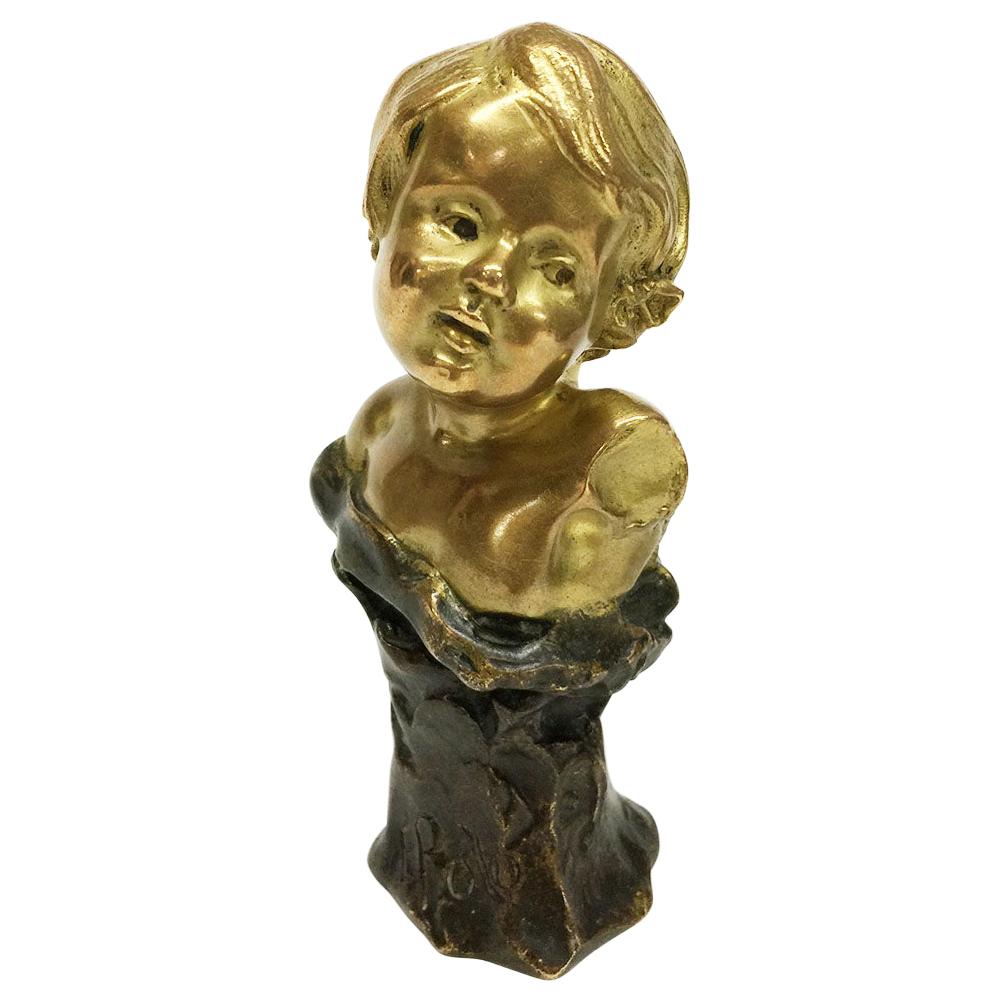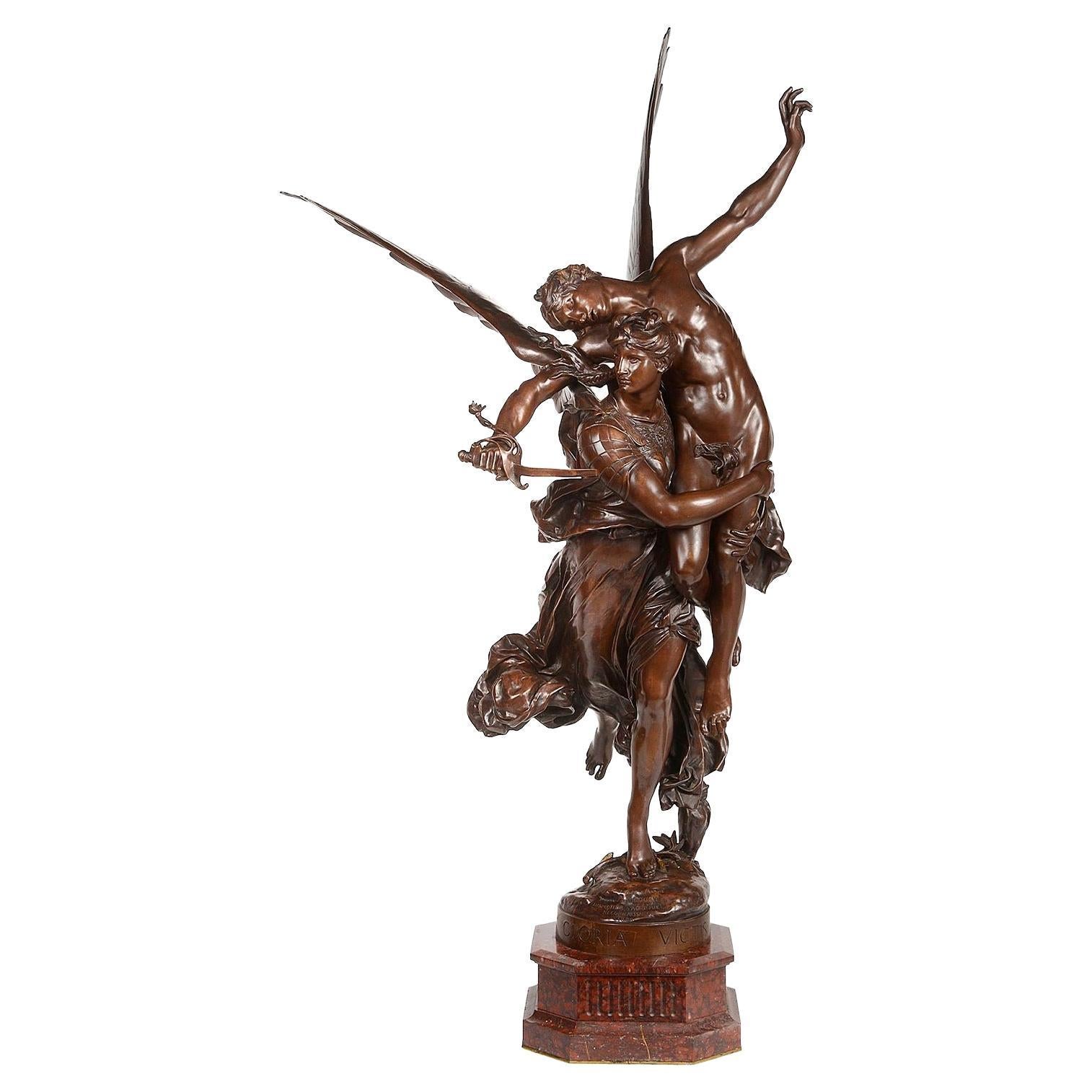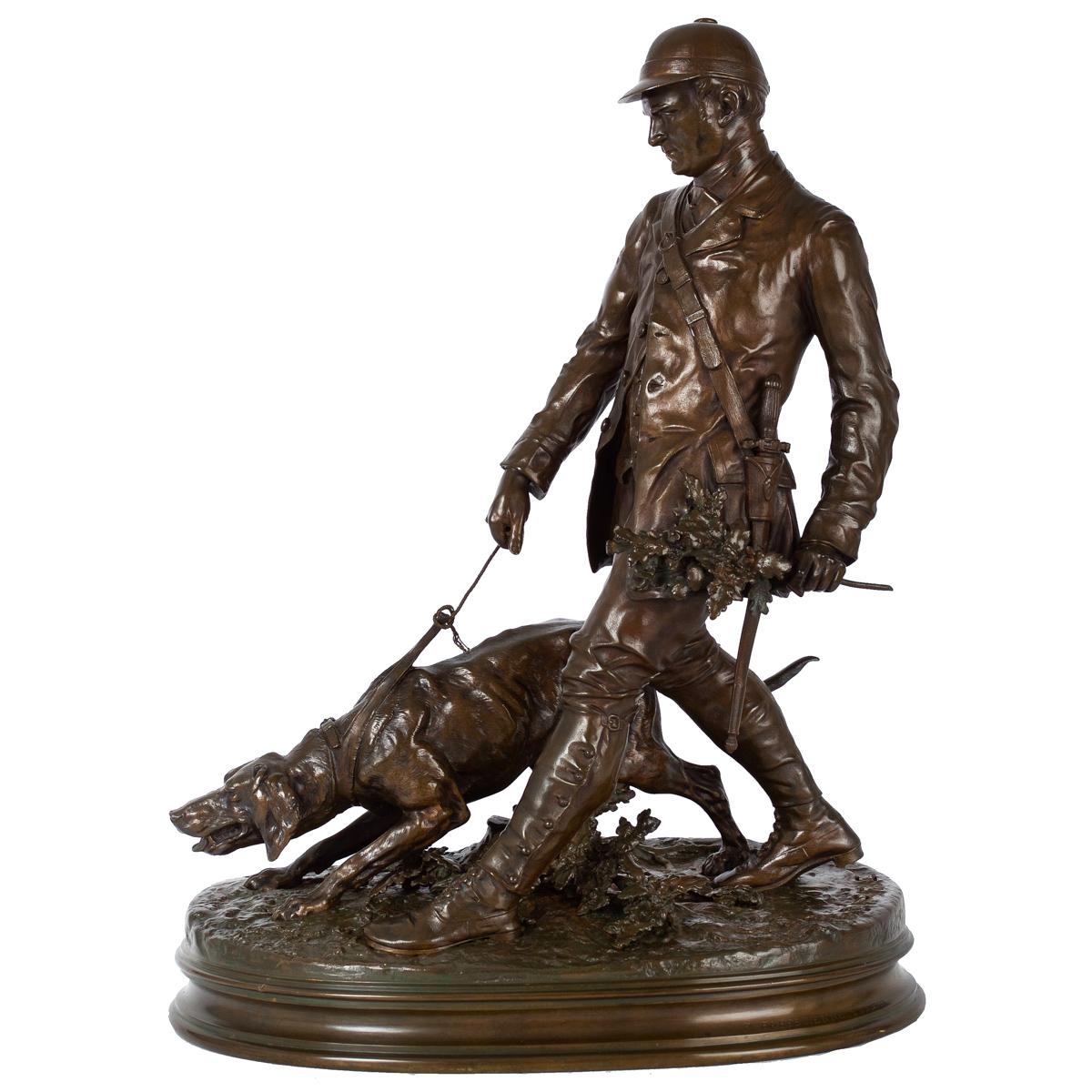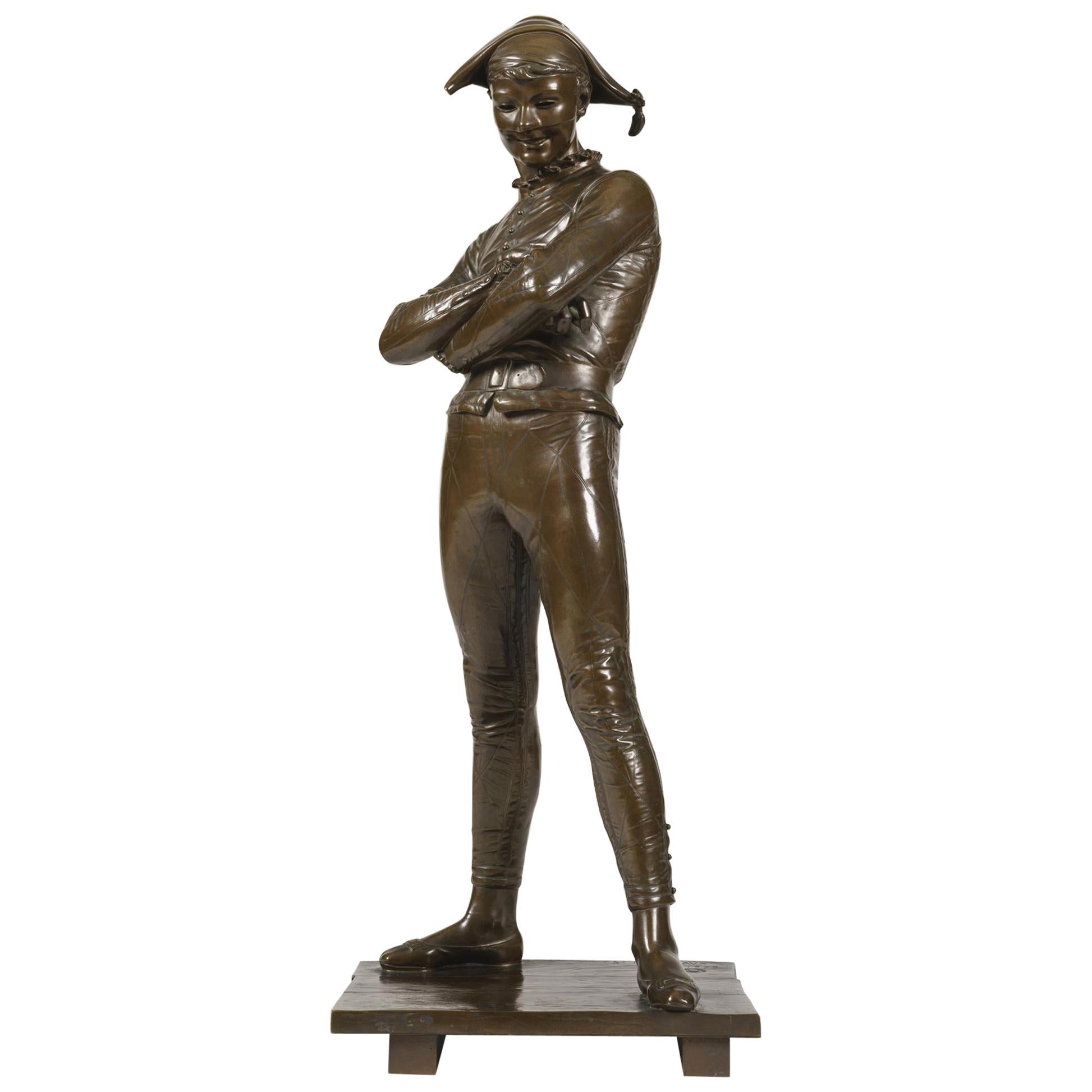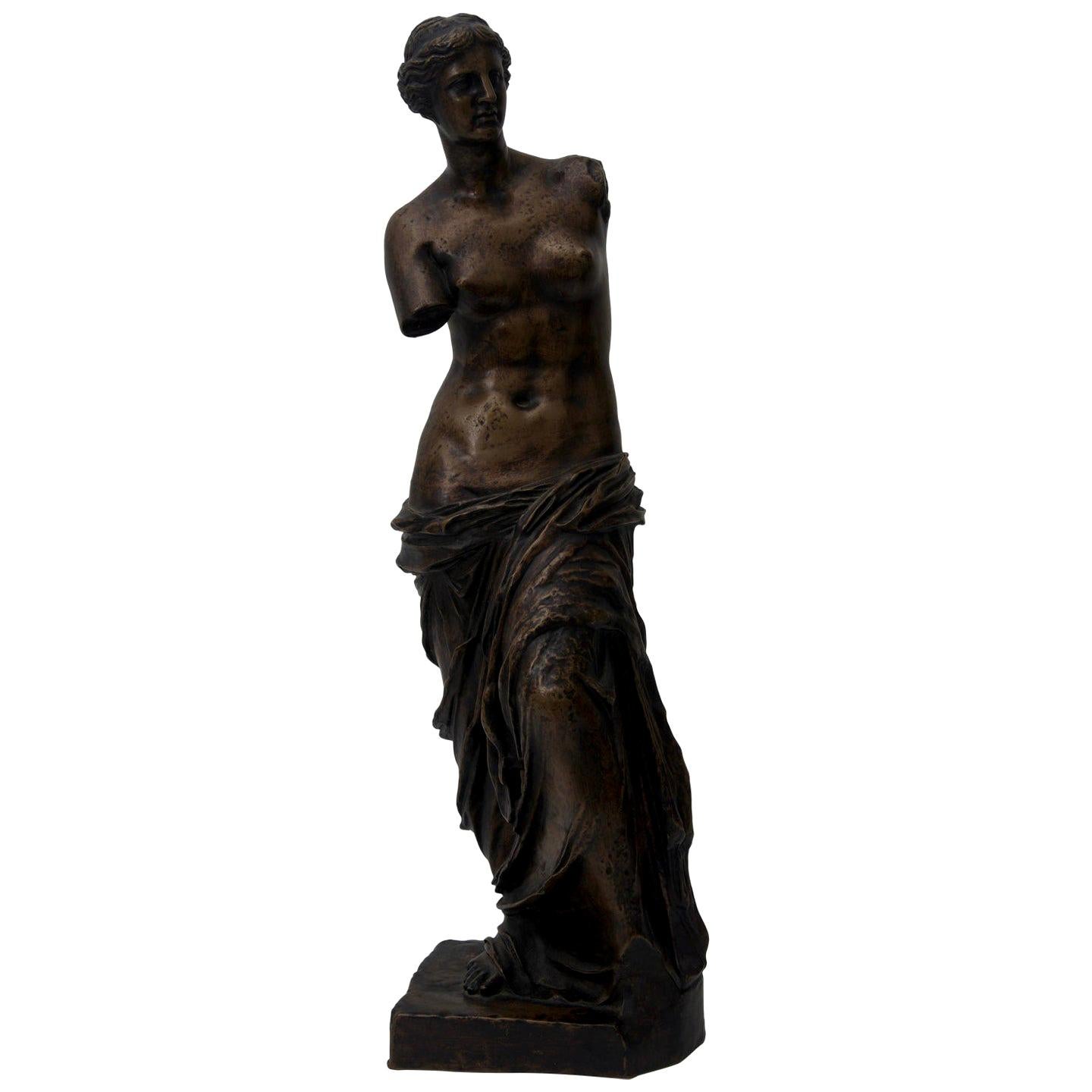Items Similar to Harlequin by R. de Saint Marceaux, Cast by F. Barbedienne, France, Circa 1880
Video Loading
Want more images or videos?
Request additional images or videos from the seller
1 of 12
Harlequin by R. de Saint Marceaux, Cast by F. Barbedienne, France, Circa 1880
About the Item
Signature of René Saint-Marceaux and dated 1879
Signed F. Barbedienne Fondeur Paris
A. Collas Mechanical Reduction Stamps
Reduced Size: 3/5
Elegant statue of a standing Harlequin, slightly leaning back, in patinated bronze with gilt highlights.
Standing on a quadrangular base imitating the floor, this emblematic commedia dell'arte figure is recognizable by his bicorne hat, mask, diamond-shaped pattern jacket and mischievous smile.
This sculpture was a huge success at the end of the century, contributing to the fame of sculptor René de Saint Marceau, which encouraged production in a variety of sizes and materials; the Musée des Beaux-Arts de Reims conserves the original plaster (see photo attached) dated 1879, Height. 175 cm (inventory no. 880.19.1) and another bronze version, Height. 34.2 cm, numbered 41411, (inventory number: 941.3.208).
The plaster cast was exhibited at the 1880 Salon des Artistes, and a contract was signed on October 1st, 1880 between the sculptor, René de Saint-Marceau, and the bronze-caster, Ferdinand Barbedienne, to produce the statue in various sizes using the A. Collas mechanical reduction process.
F. Barbedienne proposed it for sale in various reduction sizes:
3/5 (Height: 103 cm; Depth: 39 cm), 1/2 (Height: 85 cm; Depth: 32 cm), 2/5 (Height: 69 cm; Depth: 0.26 m), 3/10 (Height: 51 cm; Depth: 19 cm), 1/4 (Height: 43 cm; Depth: 16 cm), 1/5 (Height: 34 cm; Depth: 13 cm).
Biography :
René de Saint-Marceaux is a French sculptor born on September 23, 1845 in Reims (Marne), who moved to Paris in 1863 to study with sculptor François Jouffroy at the École des Beaux-Arts until 1869. During his studies, in 1868, he participated for the first time at the Paris Salon. The end of his academic career was influenced by Michelangelo, whom he studied during a trip to Italy in 1869. He continued to studies from life in 1873-1874, traveling to Florence, then to Morocco and Spain between 1874 and 1879.
Known and recognized in particular for his Harlequin, he was finally elected as a member of the Académie des Beaux-Arts in 1905.
Born in 1810, Ferdinand Barbedienne started one of the most famous 19th century artistic bronze casting companies. He died in 1892. In addition to his personal production, he worked for famous artists such as Clésinger, Carrière-Belleuse and Guillemin. Barbedienne’s production was always highly esteemed, and he was, himself admired by contemporary art critics who compared him during the 1878 Universal Exhibition to a « prince of industry and the king of bronze-casting ». In the catalogue of the Exhibition, Barbedienne was considered as the leader among 19th century bronze casters, because of the exquisite quality of his bronzes.
Achille Collas was a French engineer born in Paris in 1795, continuing his studies until 1814, when he joined the technical services of La Grande Armée. His main work, however, was on new engraving processes, including the Collas Process used for the Trésor de numismatique et de glyptique, designed by archaeologist Charles Lenormant and painter Paul Delaroche and published from 1831 by Goupil et Rittner, a work that won acclaim at the 1833 Salon.
However, it was the invention of the pantograph, enabling any sculpture to be reproduced in any size, that made his company a success. Many artists turned to this new mechanical reduction process, such as the Venus de Milo or Harlequin, to distribute their works more widely.
This process ensured him a major place in 19th-century production, a position that was reinforced by his collaboration with Ferdinand Barbedienne from 1845 onwards. This collaboration was marked by a number of successes, including a first medal at the London World's Fair in 1851 and then at the World's Fair in 1855. The company continued to flourish after the death of Achille Collas.
Bibliography :
- Les Bronzes Barbedienne - L'oeuvre d'une dynastie de fondeurs (1834-1954), Florence Rionnet, Arthena, 2016
- Creator:F. Barbedienne Foundry (Metalworker),René de Saint-Marceaux (Sculptor)
- Dimensions:Height: 40.56 in (103 cm)Width: 15.16 in (38.5 cm)Depth: 13.59 in (34.5 cm)
- Materials and Techniques:Bronze,Patinated
- Place of Origin:
- Period:
- Date of Manufacture:circa 1880
- Condition:Wear consistent with age and use.
- Seller Location:PARIS, FR
- Reference Number:
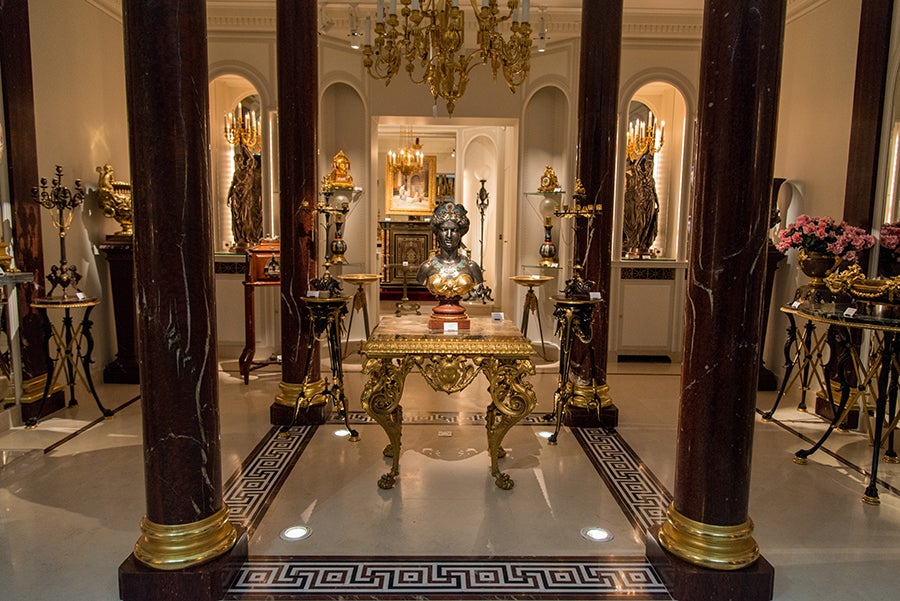
About the Seller
4.9
Vetted Seller
These experienced sellers undergo a comprehensive evaluation by our team of in-house experts.
Established in 1997
1stDibs seller since 2018
74 sales on 1stDibs
Typical response time: <1 hour
Associations
International Confederation of Art and Antique Dealers' Associations
- ShippingRetrieving quote...Ships From: PARIS, France
- Return PolicyA return for this item may be initiated within 7 days of delivery.
More From This SellerView All
- Magnificent Console by Barbedienne, Falguière and Dubois, France, Circa 1880By F. Barbedienne Foundry, Paul Dubois, Jean Alexandre Joseph Falguière 1Located in PARIS, FRTotal height with mirror: 383 cm (151 in.) Console : Height : 97 cm (38 in.) ; Length : 291 cm (114 in.) ; Depth : 47 cm (18 in.) Height with pedestals : 178 cm (70 in.) – Width of pedestals tops : 36 x 23 cm (14 x 9 in.) Provenance: Hôtel de Bourbon-Condé, for the Conte de Chambrun, 12 rue Monsieur, 7th arrondissement, Paris. This magnificent white carrare and bleu turquin marble Louis XVI style console is embellished with carved and gilded bronze ornaments. The belt, adorned with a fluted frieze, masks of Bacchus and rosettes, is standing on six spirally fluted feet with foliage on the extremities. The part meant to be placed against the wall is divided in several pannels framed with moulded and beaded bronze. Above the console stands a giltwood and white-painted mirror, richly decorated at its top with a carved head of Apollo flanked by acanthus leaves and treillis. The mirror is framed by two patinated bronze female figures, each holding seven-light candelabra and standing on pedestals richly adorned with laurel garlands and bronze frames. These are casts by F.Barbedienne, after models by J.A.J. Falguière and P.Dubois (they are signed to the base, one ‘FALGVIERE and F.BARBEDIENNE. FONDEUR’, the other ‘P.DUBOIS’ and ‘F.BARBEDIENNE’). The original models of these bronzes were shown at the 1867 Exposition Universelle before being installed at the Château de Compiègne for the enjoyment of Napoleon III and Empress Eugénie. The masterful console was commissionned to Barbedienne around 1880 to garnish the interiors of the Conte de Chambrun at the Hôtel de Bourbon-Condé, 12 rue Monsieur, 7th arrondissement, Paris. This console was part of the sale of the count’s art and furniture collections that took place on the 18th of June 1900 after the count’s death (listed as lot n°52 in the sale catalogue). Born in 1810, died in Paris in 1892, Ferdinand Barbedienne, the most important caster of bronze pieces of art during the second half of the 19th Century, created and directed in Paris one of the major artistic founderies of his time. Barbedienne specialised in classical reproductions, whose models were exposed in famous European museums. Their illustrated catalogues included many diverse objects such as busts, ornemental sculpture (clocks, candelabras, cups) sometimes even life-sized and also bronzes for furniture. Apart from his own production, Barbedienne worked for the most renowned sculptors such as Barrias, Clésinger and Carrier-Belleuse. All his works were highly esteemed and he, himself honoured by contemporary critics. At the London exhibition in 1851 Barbedienne's firm won two « Council medals ». At the 1855 Universal Exhibition, he won a medal of honour. The success of Barbedienne's firm brought him many official commissions. At the London Universal Exhibition of 1862 Barbedienne won medals in three different categories : Furniture, Silversmith work and Artistic bronzes. Barbedienne was made an officer of the Légion d'Honneur in 1867 and Commander in 1878 when he was compared with « a prince of industry and the king of bronze casting ». His glory did not decline with the passage of the time for at the Universal Exhibition of 1889 the critics thanked Barbedienne for the example he set for other bronze-casters by the perfection of his bronzes. Paul Dubois (1829-1905) studied law before entering the workshop of Toussaint, then the School of Fine Arts. After travelling in Italy, he participated to the Salon of 1863 and won the third medal for the sculpture category. He won several other medals : the Medal of Honour with his Florentine Singer...Category
Antique 1880s French Louis XVI Pier Mirrors and Console Mirrors
MaterialsMarble, Bronze
- "Florentine Singer" Bronze Sculpture by P. Dubois and F. Barbedienne, Circa 1880By Paul Dubois, Ferdinand BarbedienneLocated in PARIS, FRSigned P. Dubois 1865 and F. Barbedienne fondeur Stamped with réduction mécanique Collas A patinated bronze « Florentine Singer » sculpture, inspir...Category
Antique 1880s French Figurative Sculptures
MaterialsBronze
- Ottoman Style Chandelier by F. Barbedienne, France, circa 1880By Ferdinand BarbedienneLocated in PARIS, FRSigned F. Barbedienne Rare Ottoman style gilded bronze chandelier composed of an openwork crown, from which ten arms of light emerge, holding six transparent glasses decorated with ...Category
Antique 1880s French Islamic Chandeliers and Pendants
MaterialsBronze
- Pair of Small Cloisonné Enamel Vases by F. Barbedienne, France, Circa 1880By Ferdinand BarbedienneLocated in PARIS, FRSigned F. Barbedienne on the mount. Charming pair of small curved-shaped vases in patinated and gilded bronze and polychrome cloisonné enamel decorated with flowers and birds. With ...Category
Antique 1880s French Japonisme Vases
MaterialsBronze, Enamel
- Neo-Greek Gueridon Attributed to F. Barbedienne, France, Circa 1880By Louis-Constant Sevin, Ferdinand BarbedienneLocated in PARIS, FRA similar model was exposed at the 1889 Paris Universal Exhibition ( see picture attached) Patinated and gilded bronze gueridon with four paw feet joined by X-shaped stems, attributed to Sévin and Barbedienne. Round green marble top mounted with a bronze rim adorned with oves and pearls motif. Born in 1821 and dead in Paris in 1888, Louis-Constant Sévin was apprenticed to the parisian sculptor Marneuf. In 1839, he joined the sculptor-modelors Phénix and Joyau, as designer, and designed silver-smith’s objects for famous firms like Denière, Froment-Meurice, Morel and Duponchel. During the Revolution in 1848, C. Sévin joined Morel in London, as workshop manager and designed pieces that Morel exhibited in 1851. Back in France in 1851, C. Sévin went to Limoges and designed models for the porcelain factories of Jouhanneaud and Dubois of which many pieces were exhibited at the Universal Exhibition in 1855. From this date on, he worked for Ferdinand Barbedienne as sculptor-ornemanist until the end of his life. Sévin’s works are considerable, he designed furniture bronzes for the « hôtel de La Païva ». At the London Exhibition in 1862, he was awarded a medal « pour l’excellence artistique des meubles qu’il a dessinés et qui sont exposés par Barbedienne » : for the artistic excellence of the furniture he designed and which is exhibited by F. Barbedienne. He won a second class medal at the Union centrale des Arts décoratifs Exhibition in 1863 and was awarded a gold medal as « cooperator ». F. Barbedienne said that posterity would remember Sévin’s compositions. The most extraordinary object designed by C. Sévin for F. Barbedienne, was a Renaissance style gilded bronze monumental clock...Category
Antique 1880s French Greek Revival Center Tables
MaterialsMarble, Bronze
- Pair of Neo-Greek Amphora Vases by Barbedienne and Levillain, France, circa 1880By Ferdinand Levillain, Ferdinand BarbedienneLocated in PARIS, FRPair of Greek style vases made two patina bronze. Each, designed in the shape of a tripod amphora adorned with Hercules heads, is decorated in low-relief...Category
Antique 1880s French Greek Revival Vases
MaterialsGriotte Marble, Bronze
You May Also Like
- Small Gilded French Bronze Bust by Rene de Saint-Marceaux, 1897By René de Saint-Marceaux, Louchet FoundryLocated in Delft, NLSmall antique gilded French bronze bust by Rene de Saint-Marceaux Named and marked E. Polo and dated 1897 This small gilded bronze is a bust of a child signed D. St. Rene for Ren...Category
Antique 19th Century French Busts
MaterialsBronze
- Bronze Statue of Arlequin by Charles-René de Paul de Saint-MarceauxBy René de Saint-MarceauxLocated in Los Angeles, CAA Bronze Statuette of Arlequin by Charles-René de Paul de Saint-Marceaux. Cast by Barbedienne. The mischievous Harlequin, arms crossed in contemplation, wearing a grin and a mask, treading the boards of the stage, as befits his leading place in the Commedia dell'arte. Signed by the fondeur, Ferdinand Barbedienne, having the foundry cachet, and dated 1879, and the sculptor's name, St. Marceaux. French, Circa 1880. Paul de Saint-Marceaux (1845-1915) Son of a Reims wine merchant, entered the Ecole des Beaux-Arts de Paris under the tutelage of Jouffroy, exhibiting at the Salon of 1868, studying later in Italy. Considerable success followed, and he was awarded gold medals at the Paris Exposition Universelle of 1889, having been elected as a Chevalier to the Legion d'Honneur in 1880, and later becoming an officer. His public Parisian works may be seen in the Champs-Elysees (Alphonse Daudet the noted novelist) and Alexander Dumas...Category
Antique 1870s French Figurative Sculptures
MaterialsBronze
- Bronze statue of Gloria Victis, circa 1880, by BarbedienneBy F. Barbedienne FoundryLocated in Brighton, SussexA fine quality bronze sculpture of Gloria Carrying the Angel Victis, Cast by Barbedienne and After a Model by Marius-Jean-Antonin Mercie´ (French, 1845-1916). The draped figure...Category
Antique 19th Century French Figurative Sculptures
MaterialsBronze
- French Bronze Sculpture "Valet de Limier" by Pierre Jules Mene & BarbedienneBy F. Barbedienne FoundryLocated in Shippensburg, PAPIERRE JULES MENE French, 1810-1879 "Valet de Limier" (1879) Patinated bronze Signed in cast "P.J. MÊNE", incised "F. BARBEDIENNE FONDEUR" to base Item # 109LWK22S This was the...Category
Antique 19th Century French Romantic Animal Sculptures
MaterialsBronze
- Antique Bronze Statue of Arlequin by René de Saint-MarceauxBy Ferdinand BarbedienneLocated in London, GBA bronze Statuette of Arlequin by Charles-René de Paul de Saint-Marceaux Cast by Barbedienne. The mischievous Harlequin, arms crossed in contemplation, wearing a grin and a mask, tr...Category
Antique 1880s French Belle Époque Figurative Sculptures
MaterialsBronze
- Bronze Sculpture of the Venus de Milo by F. BarbedienneBy F. Barbedienne FoundryLocated in West Palm Beach, FLThis cast bronze sculpture of the Venus de Milo dates to the 1860s-1880s and was cast by the F. Barbedinne foundry in Paris started in 1838 by Ferdinand Barbedienne and Achille Colla...Category
Antique Late 19th Century French Grand Tour Figurative Sculptures
MaterialsBronze
